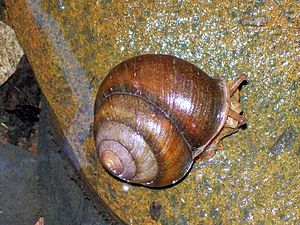- Camaenidae
-
Camaenidae 
Meridoulum gulosum
Systematik Unterklasse: Orthogastropoda Überordnung: Heterobranchia Ordnung: Lungenschnecken (Pulmonata) Unterordnung: Landlungenschnecken (Stylommatophora) Überfamilie: Helicoidea Familie: Camaenidae Wissenschaftlicher Name Camaenidae Rafinesque, 1815 Die Camaenidae sind eine der artenreichsten Familien aus der Unterordnung der Landlungenschnecken (Stylommatophora). Camaenidae sind in weiten Teilen Asiens, sowie in Papua Neuguinea, den Salomonen und Australien weit verbreitet. Sie besiedeln eine Vielzahl von Habitaten, von tropischen Regenwäldern bis hin zu Wüsten. Das Zentrum der Diversität liegt in Südostasien.
Inhaltsverzeichnis
Merkmale
Die Gehäuse sind mäßig groß bis groß. Form, Ornamentierung und Farbe variieren in weiten Grenzen. Oft ist auch eine hohe innerartliche Variabilität vorhanden. Der Umbilikus ist offen oder geschlossen. Die Mündung ist ebenfalls vielgestaltig, häufig ist auch ein umgeschlagener Mündungsrand. Selten jedoch sind Zähne vorhanden, die in die Mündung ragen. Charakteristisch ist das Fehlen von Diverticulum und Liebespfeilsack im Geschlechtsapparat.
Systematik
Die Untergliederung der Camaenidae in Unterfamilien (Camaeninae, Rhagadinae, Sinomeloinae) ist derzeit umstritten und nicht allgemein anerkannt und bedarf einer Überprüfung durch vergleichende phylogenetische Untersuchungen. Eine artenreiche Gruppe amerikanischer Arten wurden bis vor kurzem ebenfalls den Camaenidae zugeordnet. Neueste phylogenetische Studien haben jedoch gezeigt, dass diese Schnecken einer anderen Familie, den Pleurodontidae, zuzuordnen sind. [1][2]
Gattungen
Derzeit werden 87 Gattungen innerhalb der Familie anerkannt.
Gattungen, die hauptsächlich in Südostasien verbreitet sind:
- Camaena Albers, 1850
- Amphidromus Albers, 1850
- Chloritis Beck, 1837[3]
- Moellendorffia
- Obba
- Satsuma
- Stegodera
- Trachia
Gattungen, die hauptsächlich in Papua Neuguinea und auf den Salomonen verbreitet sind:
- Albersia
- Calycia H. Adams, 1865
- Canefriula
- Cryptaegis
- Crystallopsis
- Forcartia
- Ganesella
- Mecyntera
- Megalocron
- Meliobba
- Papuanella
- Papuexul
- Papuina Martens, 1860
- Papustyla
- Planispira Beck, 1837
- Rhynchotrochus
- Rhytidoconcha
- Smeatonia
Gattungen aus Australien
- Adclarkia Stanisic, 1996[4]
- Amplirhagada Iredale, 1933[5]
- Arnemelassa Iredale, 1938[6]
- Aslintesta Solem, 1992[7]
- Austrochloritis Pilsbry, 1890[8]
- Badistes
- Basedowena Iredale, 1937[9]
- Baudinella Thiele, 1931[10]
- Bentosites
- Calvigenia
- Caperantrum
- Carinotrachia Solem, 1985
- Chloritisanax
- Contramelon
- Cooperconcha
- Crikey Stanisic, 2009 – mit einer Art, Crikey steveirwini Stanisic, 2009[11]
- Cristigibba
- Cristilabrum
- Cupedora
- Damochlora
- Dirutrachia
- Discomelon
- Divellomelon
- Exiligada
- Eximiorhagada
- Falspleuroxia
- Galadistes
- Gloreugenia
- Glyptorhagada
- Gnarosophia
- Granulomelon
- Hadra Albers, 1860
- Jacksonena
- Kendrickia
- Kimberleydiscus Köhler, 2010 – mit einer Art, Kimberleydiscus fasciatus Köhler, 2010[12]
- Kimberleymelon Köhler, 2010 – mit einer Art, Kimberleymelon tealei Köhler, 2010[12]
- Kimboraga
- Lacustrelix
- Meliobba
- Melostrachia
- Meridolum
- Mesodontrachia
- Micromelon
- Minimelon
- Montanomelon
- Monteithosites
- Mouldingia
- Mussonena
- Neveritis
- Ningbingia
- Noctepuna
- Obstengenia
- Offachloritis
- Ordtrachia
- Pallidelix
- Parglogenia
- Plectorhagada
- Pleuroxia
- Posorites
- Promonturconchum
- Prototrachia
- Prymnbriareus
- Pseudcupedora
- Quistrachia
- Ramogenia
- Rhagada Albers, 1860
- Retroterra
- Semotrachia
- Setobaudinia
- Sinumelon Iredale, 1930
- Sphaerospira
- Spurlingia
- Strepsitaurus
- Tatemelon
- Temporena
- Thersites
- Tolgachloritis
- Torresitrachia
- Trachiopsis
- Trozena
- Turgenitubulus
- Varohadra
- Ventopelita
- Vidumelon
- Westraltrachia
- Xanthomelon Martens, 1860
Quellen
- ↑ Wade, C.M., Hudelot, C., Davison, A., Naggs, F., Mordan, P.B. Molecular phylogeny of the helicoid land snails (Pulmonata: Stylommatophora: Helicoidea), with special emphasis on the Camaenidae. Journal of Molluscan Studies 73: 411-415.
- ↑ Bouchet, P., Rocroi, J.P. Classification and Nomenclator of gastropod families. Malacologia 47: 1-397.
- ↑ Maassen W. J. M. (2009). „Remarks on the genus Chloritis in Sulawesi, Indonesia, with the descriptions of two new species (Gastropoda: Pulmonata: Camaenidae)“. Zoologische Mededelingen 83 HTM.
- ↑ Stanisic, J. 1996. New land snails from boggomoss environments in the Dawson Valley, southeastern Queensland (Eupulmonata: Charopidae and Camaenidae). Memoirs of the Queensland Museum 39: 343-354
- ↑ Iredale, T. 1933. Systematic notes on Australian land shells. Records of the Australian Museum 19: 37-59
- ↑ Iredale, T. 1938. A basic list of the land Mollusca of Australia. Pt III. Australian Zoologist 9: 83-124
- ↑ Solem, A. 1992. Camaenid land snails from southern and eastern South Australia, excluding Kangaroo Island. Pt 1. Systematics, distribution and variation. Records of the South Australian Museum Monograph Series 2: 1-338
- ↑ Pilsbry, H.A. 1890. in Tryon, G.W. & Pilsbry, H.A. Manual of Conchology. Philadelphia : Conchological Section, Academy of Natural Sciences Ser. 2 Vol. 6 324 pp.
- ↑ Iredale, T. 1937. An annotated check list of the land shells of South and Central Australia. South Australian Naturalist 18: 6-59
- ↑ Thiele, J. 1931. Handbuch der Systematischen Weichtierkunde. Jena : Gustav Fischer pp. 377-778
- ↑ Stanisic J. (24 August) 2009. Crikey steveirwini gen. et sp. nov. from montane habitats in the Wet Tropics of northeastern Queensland, Australia (Gastropoda: Eupulmonata: Camaenidae). Zootaxa 2206: 62–68. abstract.
- ↑ a b Köhler F. (2010). „Three new species and two new genera of land snails from the Bonaparte Archipelago in the Kimberley, Western Australia (Pulmonata, Camaenidae)“. Molluscan Research 30(1): 1-16.
Literatur
- Philippe Bouchet & Jean-Pierre Rocroi: Part 2. Working classification of the Gastropoda. Malacologia, 47: 239-283, Ann Arbor 2005 ISSN 0076-2997
Weblinks
Wikimedia Foundation.
